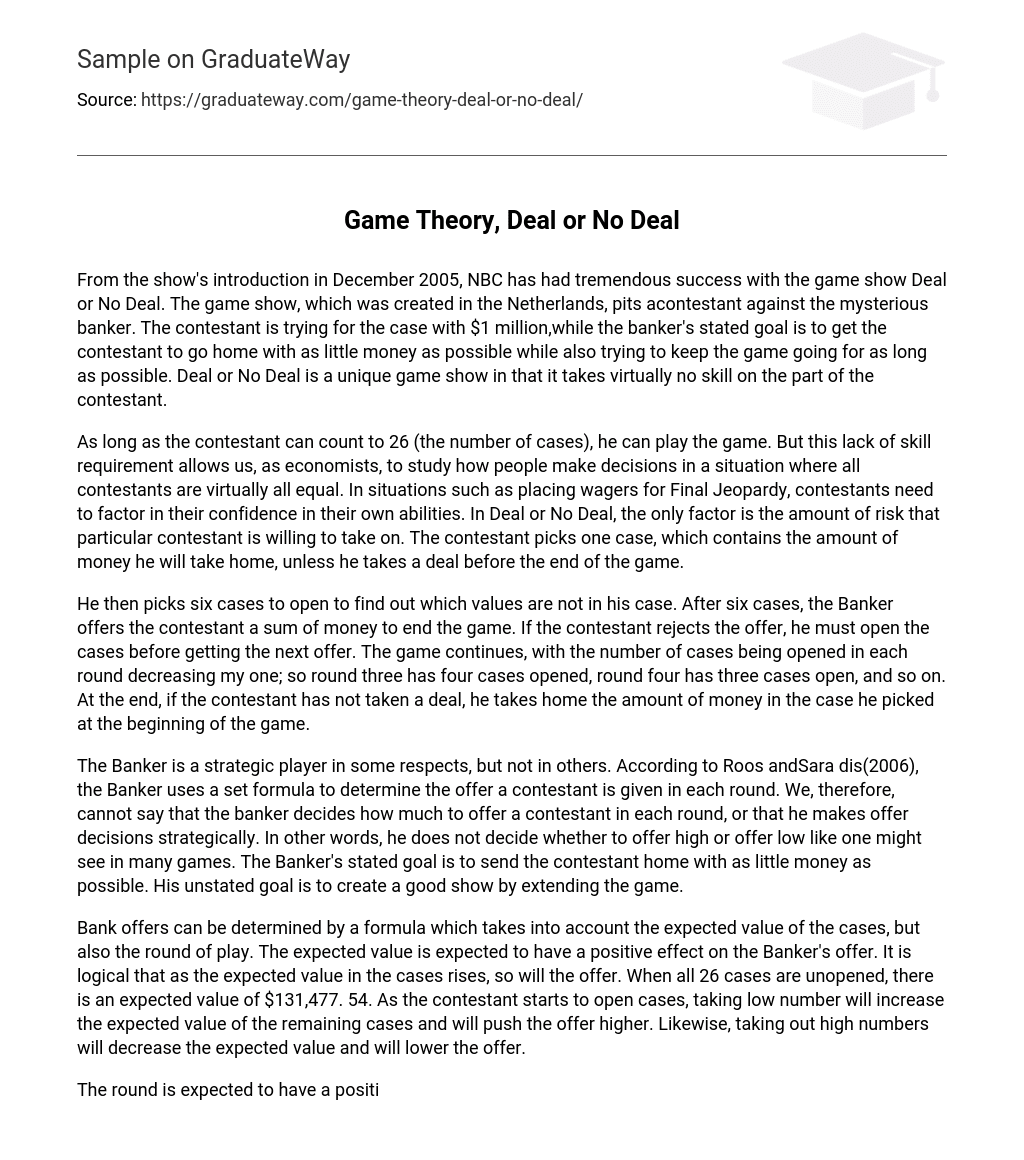From the show’s introduction in December 2005, NBC has had tremendous success with the game show Deal or No Deal. The game show, which was created in the Netherlands, pits acontestant against the mysterious banker. The contestant is trying for the case with $1 million,while the banker’s stated goal is to get the contestant to go home with as little money as possible while also trying to keep the game going for as long as possible. Deal or No Deal is a unique game show in that it takes virtually no skill on the part of the contestant.
As long as the contestant can count to 26 (the number of cases), he can play the game. But this lack of skill requirement allows us, as economists, to study how people make decisions in a situation where all contestants are virtually all equal. In situations such as placing wagers for Final Jeopardy, contestants need to factor in their confidence in their own abilities. In Deal or No Deal, the only factor is the amount of risk that particular contestant is willing to take on. The contestant picks one case, which contains the amount of money he will take home, unless he takes a deal before the end of the game.
He then picks six cases to open to find out which values are not in his case. After six cases, the Banker offers the contestant a sum of money to end the game. If the contestant rejects the offer, he must open the cases before getting the next offer. The game continues, with the number of cases being opened in each round decreasing my one; so round three has four cases opened, round four has three cases open, and so on. At the end, if the contestant has not taken a deal, he takes home the amount of money in the case he picked at the beginning of the game.
The Banker is a strategic player in some respects, but not in others. According to Roos andSara dis(2006), the Banker uses a set formula to determine the offer a contestant is given in each round. We, therefore, cannot say that the banker decides how much to offer a contestant in each round, or that he makes offer decisions strategically. In other words, he does not decide whether to offer high or offer low like one might see in many games. The Banker’s stated goal is to send the contestant home with as little money as possible. His unstated goal is to create a good show by extending the game.
Bank offers can be determined by a formula which takes into account the expected value of the cases, but also the round of play. The expected value is expected to have a positive effect on the Banker’s offer. It is logical that as the expected value in the cases rises, so will the offer. When all 26 cases are unopened, there is an expected value of $131,477. 54. As the contestant starts to open cases, taking low number will increase the expected value of the remaining cases and will push the offer higher. Likewise, taking out high numbers will decrease the expected value and will lower the offer.
The round is expected to have a positive effect on the offer. The Banker wants to keep contestants in the game for as long as possible to keep the show interesting. Therefore, he won’t make a particularly intriguing offer for at least a few rounds. The goal of the contestant is to take as much money home as possible. This goal is reached through a combination of luck and good decision making. There is relatively little skill needed to win large amounts of money, just the ability to decide when it is time to end the game and take the offer.
This lends itself nicely to applying game theory because it takes strategy but not skill to do well. It also means that a player’s move is determined by their risk tolerance. The contestant’s decision making rule is based on the utility that the contestant receives from the offer amount, the expected value of the remaining cases, and of the risk of continuing. Therefore, in order for the contestant to continue their utility from the offer must be less than the sum of the utility from the expected value and the utility from the risk.
One way to measure risk is by using the standard deviation of the remaining cases. In other words,there is a greater risk involved with continuing when the remaining cases are very far apart than when they are close together. Two sets of cases can have the same expected value, yet have much different risk levels associated with not taking the deal. A large standard deviation will mean that there is more risk of getting a substantially lower pay-out than if there is a small standard deviation. Take, for example, a set of cases with $100,000 and $200,000 and another set with $0. 1 and 300,000. These two sets of cases have almost the same expected value ($150,000), but the deal is much more enticing for the second group because of the much higher standard deviation. How a person interprets and handles the risk associated with the standard deviation depends on how much they like risk. Someone who is risk averse will be less willing to play on when facing a case set with a high standard deviation than someone who is risk seeking. The contestant’s risk tolerance can be measured by the deal they take.





